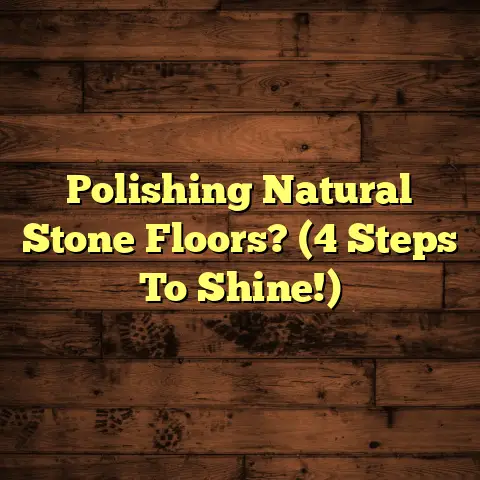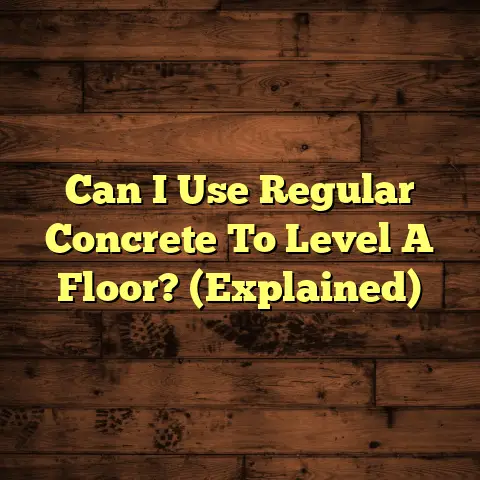Cleaning Non-Waterproof Laminate (1 Mistake Ruins!)
In a world where we’re told that a little water never hurt anyone, the tragic tale of non-waterproof laminate flooring begs to differ. I’ve seen it happen countless times. Homeowners, thinking they’re doing the right thing, grab a mop and bucket, only to unknowingly set their beautiful laminate on a path to destruction. It’s a heartbreaker, especially considering how easily preventable it is.
1. Introduction
Non-waterproof laminate flooring has become a staple in many modern homes. I’ve installed tons of it over the years. It’s easy to see why. It offers the look of hardwood or tile without the hefty price tag. Plus, it’s generally easier to install, making it a popular choice for DIY enthusiasts and budget- conscious homeowners alike.
Think about it. Laminate gives you that aesthetic appeal you’re after. It’s more affordable, and the installation? A breeze compared to, say, laying hardwood. What’s not to love?
But here’s the kicker. That affordability and ease of installation come with a catch. Non-waterproof laminate is vulnerable. One wrong move during cleaning – specifically, overusing water – can lead to irreversible damage. I’m talking warping, swelling, and even mold growth. Trust me, I’ve seen it all.
That’s why I’m writing this. I want to equip you with the knowledge you need to keep your laminate looking its best for years to come. I’ll walk you through the ins and outs of non-waterproof laminate, highlight the common cleaning mistakes, and provide you with safe and effective cleaning solutions.
Consider this your ultimate guide to laminate longevity. Let’s dive in, shall we?
2. Understanding Non-Waterproof Laminate
So, what exactly is non-waterproof laminate? And how does it differ from those fancy waterproof alternatives you might have heard about?
Let’s break it down.
Non-waterproof laminate flooring is essentially a multi-layered synthetic flooring product. Typically, it consists of:
- A wear layer: This is the top layer, designed to resist scratches, stains, and fading.
- A decorative layer: This is a high-resolution photographic image that mimics the look of wood, stone, or tile.
- A core board: This is the heart of the laminate, usually made of high-density fiberboard (HDF) or medium-density fiberboard (MDF). This is where the trouble lies with water.
- A backing layer: This layer provides stability and helps to protect the core from moisture.
The manufacturing process involves fusing these layers together under high heat and pressure. The result is a durable and attractive flooring option.
Now, here’s the critical difference between non- waterproof and waterproof laminate. Waterproof laminate typically has a waterproof core made of materials like PVC or other plastics. This prevents water from penetrating the core and causing damage. Non-waterproof laminate, on the other hand, uses that HDF or MDF core, which is highly susceptible to water damage.
I’ve seen non-waterproof laminate used in a variety of settings, from living rooms and bedrooms to hallways and dining areas. It’s a versatile option that can complement a wide range of interior design styles.
However, it’s generally not recommended for use in areas prone to moisture, such as bathrooms, laundry rooms, or basements. I always advise clients to choose waterproof options for those spaces.
Here’s a quick rundown of the benefits and drawbacks of choosing non-waterproof laminate:
Benefits:
- Affordability: Generally less expensive than hardwood or tile.
- Ease of Installation: Can often be installed as a DIY project.
- Durability: Resistant to scratches and stains (in the wear layer).
- Aesthetics: Available in a wide range of styles and colors.
Drawbacks:
- Susceptible to Water Damage: The core can swell and warp if exposed to excessive moisture.
- Not Suitable for All Areas: Avoid using in bathrooms, laundry rooms, or basements.
- Can Feel Less “Real” Some people prefer the feel and sound of real hardwood.
Understanding these pros and cons is crucial when deciding if non-waterproof laminate is the right choice for your home.
3. Common Cleaning Methods
Alright, let’s talk cleaning. There’s a whole arsenal of cleaning methods out there, but not all are created equal when it comes to non-waterproof laminate.
Here’s an overview of some common cleaning methods and their suitability:
- Sweeping: This is your first line of defense. Regular sweeping with a soft-bristled broom helps to remove loose dirt, dust, and debris. I recommend sweeping at least once a week, or more often in high-traffic areas.
- Vacuuming: Vacuuming is another great way to remove dirt and dust. Make sure to use a vacuum with a soft brush attachment to avoid scratching the wear layer. Avoid using vacuums with beater bars, as they can damage the flooring.
- Damp Mopping: This is where things get tricky. Damp mopping can be effective for removing stuck-on dirt and grime, but it’s crucial to use a very lightly damp mop. I’m talking barely damp. You want the mop to feel almost dry to the touch.
- Steam Mopping: I strongly advise against using steam mops on non-waterproof laminate. The high heat and moisture can easily penetrate the core and cause damage.
- Wet Mopping: This is a big no-no. Never use a wet mop on non-waterproof laminate. The excessive water will seep into the seams and cause swelling and warping.
Now, let’s talk cleaning products. There are tons of laminate floor cleaners on the market, but it’s important to choose one that’s specifically designed for laminate. Avoid using harsh chemicals, abrasive cleaners, or anything that contains bleach or ammonia. These can damage the wear layer and dull the finish.
Here are a few popular cleaning products that are generally considered safe for non-waterproof laminate:
- Bona Hardwood Floor Cleaner: Despite the name, this cleaner is safe for use on laminate floors. It’s pH-neutral and leaves no residue.
- Method Squirt + Mop Hard Floor Cleaner: This plant-based cleaner is a good option for those who prefer natural cleaning products.
- Black Diamond Stoneworks Wood & Laminate Floor Cleaner: This cleaner is specifically designed for laminate and hardwood floors and is known for its streak-free finish.
What about those household cleaning hacks you see online? Things like using vinegar and water, or baking soda and water?
While some of these hacks might work in a pinch, I generally recommend sticking to products that are specifically designed for laminate. The pH balance and ingredients in these products are formulated to clean the flooring without causing damage.
Here’s a table summarizing the pros and cons of each cleaning method:
| Cleaning Method | Pros | Cons |
|---|---|---|
| Sweeping | Easy, removes loose dirt | Doesn’t remove stuck-on grime |
| Vacuuming | Removes dirt and dust, good for large areas | Can scratch the floor if not using the right attachment |
| Damp Mopping | Removes stuck-on dirt and grime | Requires careful control of moisture, can cause damage if overdone |
| Steam Mopping | Sanitizes the floor | Not recommended – can cause significant water damage |
| Wet Mopping | Cleans thoroughly | Never do this! – will cause significant water damage |
Remember, the key to cleaning non-waterproof laminate is to use as little water as possible. Always err on the side of caution and use a barely damp mop.
4. The Critical Mistake: Overusing Water
Okay, let’s get to the heart of the matter. The single most critical mistake you can make when cleaning non-waterproof laminate is overusing water. I can’t stress this enough. It’s the silent killer of laminate floors.
Why is water so detrimental?
Well, remember that core board I mentioned earlier? The one made of HDF or MDF? These materials are highly absorbent. When water seeps into the seams between the planks, it gets absorbed by the core. As the core absorbs water, it begins to swell. This swelling can cause the planks to warp, buckle, and even separate.
The damage isn’t always immediately apparent. It might start with a slight raising of the edges of the planks. Over time, this can progress to more severe warping and buckling. In some cases, the damage can be so extensive that the entire floor needs to be replaced.
But the problems don’t stop there. Water trapped beneath the surface can also create a breeding ground for mold and mildew. This can lead to unpleasant odors, health problems, and further damage to the flooring.
I’ve seen countless cases where homeowners have unknowingly ruined their laminate floors by simply using too much water during cleaning.
Here are a few real-life examples:
- The Overzealous Mopper: A client of mine was obsessed with keeping her floors clean. She mopped them every day with a bucket of soapy water. Within a few months, her laminate floors were warped and buckled. She had to replace the entire floor.
- The Steam Mop Enthusiast: Another client used a steam mop on her laminate floors, thinking it was a safe and effective way to sanitize them. The steam penetrated the seams and caused the core to swell. The floor developed unsightly bumps and had to be replaced.
- The Spill Ignorer: I was called to inspect a laminate floor that had been damaged by a water leak. The homeowner had noticed the leak but didn’t clean it up immediately. The water seeped into the seams and caused significant warping and mold growth.
Here are some signs that indicate your laminate floor has been damaged by water exposure:
- Warping: The planks are no longer flat and even.
- Buckling: The planks are raised in the middle.
- Swelling: The edges of the planks are raised.
- Separation: Gaps appear between the planks.
- Discoloration: The flooring is stained or discolored.
- Mold or Mildew: You see or smell mold or mildew.
If you notice any of these signs, it’s important to take action immediately. Stop using water to clean the floor and try to dry the affected area as thoroughly as possible. In some cases, you may be able to repair the damage. However, if the damage is extensive, you may need to replace the flooring.
Don’t underestimate the power of water to destroy your laminate floors. Be vigilant about using as little water as possible when cleaning, and always clean up spills immediately.
5. Alternative Cleaning Solutions
So, if water is the enemy, what are the alternative cleaning solutions for non-waterproof laminate? Don’t worry, you don’t have to live with dirty floors!
Here are some safe and effective cleaning methods that won’t damage your laminate:
- Dry Cleaning Methods: As I mentioned earlier, sweeping and vacuuming are your first lines of defense. These methods effectively remove loose dirt and dust without the use of water. Use a soft-bristled broom or a vacuum with a soft brush attachment.
- Microfiber Mops: Microfiber mops are designed to trap dirt and dust without the need for water. They’re a great option for dry cleaning your laminate floors.
- Barely Damp Mopping: If you need to remove stuck-on dirt and grime, you can use a barely damp mop. Make sure to wring out the mop thoroughly so that it feels almost dry to the touch. You should barely see any moisture on the floor after mopping.
- Homemade Cleaning Solutions: There are several homemade cleaning solutions that are safe and effective for laminate floors. One popular option is to mix 1/4 cup of white vinegar with 1 gallon of water. Vinegar is a natural disinfectant and helps to remove dirt and grime without leaving a residue.
- Commercial Laminate Cleaners: As I mentioned earlier, there are several commercial laminate cleaners on the market that are specifically designed for laminate floors. These cleaners are pH-neutral and won’t damage the wear layer.
Here are a few tips for using these alternative cleaning solutions:
- Always test the cleaning solution in an inconspicuous area first to make sure it doesn’t damage the flooring.
- Use a clean mop or cloth.
- Wring out the mop or cloth thoroughly before mopping.
- Mop in the direction of the planks.
- Dry the floor immediately after mopping with a clean, dry cloth.
Maintaining the right humidity levels in your home can also help to protect your laminate flooring. Excessive humidity can cause the core to swell, even without direct water exposure.
I recommend keeping the humidity levels in your home between 30% and 50%. You can use a dehumidifier to lower the humidity levels in your home, or a humidifier to raise them.
Here’s a table summarizing the alternative cleaning solutions:
| Cleaning Solution | Pros | Cons |
|---|---|---|
| Sweeping/Vacuuming | Easy, removes loose dirt | Doesn’t remove stuck-on grime |
| Microfiber Mops | Traps dirt and dust without water | Requires regular cleaning of the mop head |
| Barely Damp Mopping | Removes stuck-on dirt and grime | Requires careful control of moisture, can cause damage if overdone |
| Homemade Vinegar Solution | Natural, effective, inexpensive | Can have a strong odor if not diluted properly |
| Commercial Laminate Cleaners | Specifically designed for laminate, pH-neutral | Can be more expensive than homemade solutions |
By using these alternative cleaning solutions and maintaining the right humidity levels in your home, you can keep your non-waterproof laminate floors looking their best for years to come.
6. Preventing Future Damage
Prevention is always better than cure, right? When it comes to non-waterproof laminate, taking proactive steps to prevent damage is crucial.
Here are some strategies for preventing damage to your laminate flooring during cleaning and everyday use:
- Use Doormats: Place doormats at all entrances to your home to trap dirt and moisture before they can get onto your laminate floors.
- Use Area Rugs: Place area rugs in high-traffic areas to protect the flooring from wear and tear.
- Use Furniture Pads: Place furniture pads under the legs of your furniture to prevent scratches and dents.
- Clean Up Spills Immediately: Wipe up spills immediately with a clean, dry cloth. Don’t let liquids sit on the floor for extended periods of time.
- Avoid Wearing Shoes Indoors: Encourage family members and guests to remove their shoes before entering your home. This will help to prevent dirt and debris from being tracked onto the floors.
- Educate Family Members and Guests: Make sure everyone in your household knows how to properly care for your laminate floors. Explain the importance of using as little water as possible when cleaning, and the dangers of using harsh chemicals or abrasive cleaners.
- Create a Cleaning Schedule: Develop a regular cleaning schedule to keep your laminate floors looking their best. Sweep or vacuum at least once a week, and damp mop as needed.
Here’s a sample cleaning schedule:
- Daily: Sweep or vacuum high-traffic areas.
- Weekly: Sweep or vacuum all laminate floors.
- Monthly: Damp mop as needed.
- As Needed: Clean up spills immediately.
Remember, consistency is key. Regular maintenance will help to prevent dirt and grime from building up on your laminate floors, making them easier to clean and less likely to be damaged.
I also recommend inspecting your laminate floors regularly for signs of damage. Look for warping, buckling, swelling, or discoloration. If you notice any of these signs, take action immediately to prevent further damage.
By following these preventative measures, you can extend the life of your non-waterproof laminate floors and keep them looking beautiful for years to come.
7. Conclusion
So, there you have it. A comprehensive guide to cleaning non-waterproof laminate flooring without ruining it. We’ve covered everything from understanding the composition of laminate to identifying the critical mistake of overusing water and exploring alternative cleaning solutions.
It’s ironic, isn’t it? We’re so used to thinking that water is the ultimate cleaner, the solution to all our messes. But when it comes to non-waterproof laminate, water can be the enemy.
The key takeaway here is that understanding the nuances of floor care is essential for maintaining your home investments. Your floors are a significant part of your home’s value and aesthetic appeal. Taking the time to learn how to properly care for them is an investment in the long-term beauty and durability of your home.
So, the next time you reach for that mop and bucket, remember the tragic tale of non-waterproof laminate flooring. A little knowledge and a little caution can go a long way in keeping your floors looking their best for years to come.
Happy cleaning!





